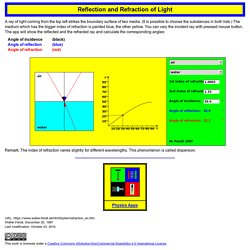

Onde: Introduzione Onde sulla corda 1.1.22 Velocity of a Pulse Propagated Through a Slinky (Simulator) : Class 9 : Physics : Amrita Online Lab. Reflecting Waves. Interferenza tra onde Diffraction Lab. Standing longitudinal waves. This HTML5 app demonstrates the harmonics of the air in a tube as an example of standing longitudinal waves.

It illustrates the movement of the molecules in the air during such an oscillation. (Obviously the particles in reality move much shorter distances, and the real movement is very quick.) The nodes, i.e. the places where the particles don't move, are marked with "N". "A" means an antinode, i.e. a place where the particles oscillate with maximal amplitude. Note that at an open end of the tube there is always an antinode, at a closed end, however, a node! You can select the form of the tube by using the appropriate radio buttons ("both sides open", "one side open" and "both sides closed"). Fisica Walker 1° biennio - Ottica geometrica.
Capitolo 6 Ottica geometrica.

Geometric Optics 2.05. Reflection and Refraction of Light. A ray of light coming from the top left strikes the boundary surface of two media.

(It is possible to choose the substances in both lists.) The medium which has the bigger index of refraction is painted blue, the other yellow. You can vary the incident ray with pressed mouse button. Rifrazione della luce 1.1.20 Refraction Lab. Refraction of light 1. Refraction of light 2. Fisica SEI.
Visione dei Colori 1.1.23 Refracting astronomical telescope. Mirrors. Mirrors and time. Mirrors and time Type of mirror: You can drag the tip of the object (red arrow) to change the object height and object distance, and you can drag the focal point (filled circle) to adjust the focal length.

Also, you can drag the tip of the image (blue arrow) to re-position the image anywhere you want, to explore why an image is formed in one special location - what is special about that point? This simulation may only appeal to me, but it is written with Richard Feynman's "explore all paths" exhortation in mind. Why is an image NOT formed at a particular point? In some cases there will not be perfect alignment, because of spherical aberration - a spherical mirror is not actually the ideal shape, so some of the outer points take a little longer or shorter than expected.
Mirrors and time. Mirrors and time Horizontal position of the object Object height.

To find focal length of a Concave Mirror (Simulation) : Class 10 : Physics : C-DAC Online Lab. To find focal length of a Concave Mirror (Animation) : Class 10 : Physics : C-DAC Online Lab. Curved mirrors. [Preview] Converging lens. Lenses. Lens Lab. Difetti visivi. Fisica SEI. The sound of Music: An interactive lesson on Standing Waves. Bell Jar Experiment (Procedure) : Class 9 : Physics : Amrita Online Lab.
Sound - The Bell Jar Experiment. Laws of Reflection of Sound (Simulator) : Class 9 : Physics : Amrita Online Lab. Doppler Lab. Atomic structure (5E) Build an atom (1) Cariche e campi elettrici 1.0.47 Elettricità statica Fisica SEI. Legge di Coulomb Fisica SEI. Campo elettrico generato da 2 cariche. Resistenza in un cavo elettrico Legge di Ohm Legge di Ohm is an interactive sim.

It changes as you play with it. It has a Play Area and a Control Area. In the Play Area you find the equation for Ohm's Law, V equals I times R, and a circuit. Voltage and resistance sliders allow changes to the equation and circuit. In the Control Area, a button allows users to reset the sim. Right now, voltage, V, is 4.5 voltsresistance, R, is 500 ohmscurrent, I, is 9.0 milliamps Look for voltage and resistance sliders to play, or read on for details about equation and circuit.
If needed, check out keyboard shortcuts under Sim Resources. Play Area Ohm's Law Equation Voltage, V, is equal to Current, I, times Resistance, R. In equation, letter V is much much larger than letter I and comparable to letter R. The Circuit A pair of wires connect a resistor to a series of batteries. Batteries supply 4.5 voltsresistor shows a medium amount of impuritiesvery small arrows indicate a current flowing clockwise at 9.0 milliamps Slider Controls Control Area.
Ohm's Law. Laboratorio condensatori: introduzione Capacitor Properties Lab. Fisica di James S. Walker II biennio - La corrente elettrica e i circuiti in corrente continua. Capitolo 15 La corrente elettrica e i circuiti in corrente continua Proponiamo un esempio di percorso didattico relativo al Capitolo 15 del volume 3, La corrente elettrica e i circuiti in corrente continua, mediante il quale è possibile organizzare la didattica a distanza.

Il testo di riferimento è disponibile per i docenti e gli studenti sotto forma di libro digitale statico (ITE) e costituisce una solida base dalla quale partire per condividere sia le pagine da studiare, sia le risorse digitali correlate. Per semplificare il lavoro, i link qui forniti consentono l’attivazione diretta di tutti i materiali, che sono reperibili anche accedendo a My Pearson Place con il codice associato al volume. Ricordiamo che l’intera Guida per il docente in formato PDF è scaricabile dall’ITE (Area docenti). YouTube. Fisica SEI. Kit creazione circuiti: corrente continua - Laboratorio virtuale Fisica 2° biennio - Il magnetismo. Capitolo 16 Il magnetismo Proponiamo un esempio di percorso didattico relativo al Capitolo 16 del volume 2, Il magnetismo, mediante il quale è possibile organizzare la didattica a distanza.

Il testo di riferimento è disponibile per i docenti e gli studenti sotto forma di libro digitale statico (ITE) e costituisce una solida base dalla quale partire per condividere sia le pagine da studiare, sia le risorse digitali correlate. Per semplificare il lavoro, i link qui forniti consentono l’attivazione diretta di tutti i materiali, che sono reperibili anche accedendo a My Pearson Place con il codice associato al volume. Ricordiamo che l’intera Guida per il docente in formato PDF è scaricabile dall’ITE (Area docenti).
Fisica SEI. Magnetic field of a bar magnet. The magnetic field of a bar magnet can be investigated with a compass needle.

The magnetic poles of both bar magnet and compass needle are symbolized by the following colours: If you move the magnetic needle with pressed mouse button, the magnetic field line through the center of the compass needle will be drawn with blue colour. The blue arrows mark the direction of the magnetic field which is defined as the direction indicated by the north pole of the compass needle. If you turn the magnet by using the red button, the direction of the field lines will reverse.
The other button makes it possible to clear all field lines. W. Magnetic Field from a Wire Lab. Magnetic field of a straight current-carrying wire. An electric current produces a magnetic field.

This applet simulates an experiment concerning the magnetic field of a straight current-carrying wire. A large current passes through a vertical wire. Lorentz Force.